
People of any age can have a milk allergy, but it's more common in infants. Many kids outgrow it, but some don't. When a baby is allergic to milk, it means that his/her immune system, which normally fights infections, overreacts to proteins in cow's milk. Every time the child has milk, the body thinks these proteins are harmful invaders and works very hard to fight them. This causes an allergic reaction in which chemicals like histamine are released in the body.Milk allergy symptoms, which differ from person to person, occur a few minutes to a few hours after drinking milk or eating milk products.
Symptoms
Immediately after consuming milk, signs and symptoms of a milk allergy might include:
- Hives
- Wheezing
- Vomiting
Signs and symptoms that may take more time to develop include:
- Loose stools, which may contain blood
- Diarrhea
- Abdominal cramps
- Runny nose
- Watery eyes
- Itchy skin rash, often around the mouth
The science behind Milk Protein Allergy (CMPA)
CMPA is a food allergy where the immune system reacts to proteins in cow’s milk. Baby’s immune system recognizes the cow’s milk protein as a foreign body, just as it would recognize a virus or bacteria, and starts to fight against it. This reaction can result in a variety of symptoms, including rash and anaphylactic shock. Reactions that occur quickly, usually 2 hours after feeding, generally include vomiting and symptoms more commonly associated with other allergic reactions, such as wheezing or noisy breathing, skin rash, hives and swelling of the eyelids or lips. Other symptoms, such as regurgitation, colic, diarrhea, constipation, runny nose, cough and skin that is dry, scaly, or itchy can develop days or even a week later.
Causes
All true food allergies are caused by an immune system malfunction. Your immune system identifies certain milk proteins as harmful, triggering the production of immunoglobulin E (IgE) antibodies to neutralize the protein (allergen). The next time you come in contact with these proteins, IgE antibodies recognize them and signal your immune system to release histamine and other chemicals, causing a range of allergic signs and symptoms.
There are two main proteins in cow's milk that can cause an allergic reaction:
- Casein, found in the solid part (curd) of milk that curdles
- Whey, found in the liquid part of milk that remains after milk curdles
Diagnosis
If you think your baby is allergic to milk, call your baby's doctor. He or she will ask you questions and talk to you about baby’s general health. After the doctor examines your baby, some stool tests and blood tests might be ordered. The doctor also may refer you to an allergist. The allergist may do skin testing. If the allergist finds that your baby is at risk for a serious allergic reaction, epinephrine auto-injectors will be prescribed.
There's no sure way to prevent a food allergy, but you can prevent reactions by avoiding the food that causes them. If you know you or your child is allergic to milk, avoid milk and all milk products. Read food labels carefully. Look for casein, a milk derivative, which can be found in some unexpected places, such as in some canned tuna or nondairy products.


